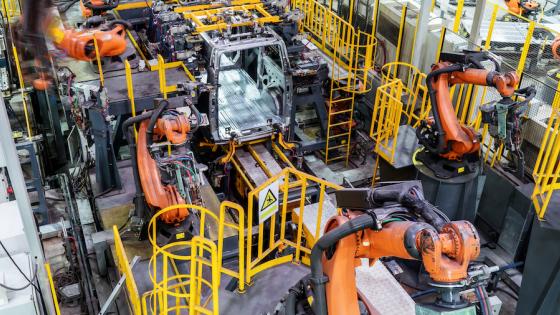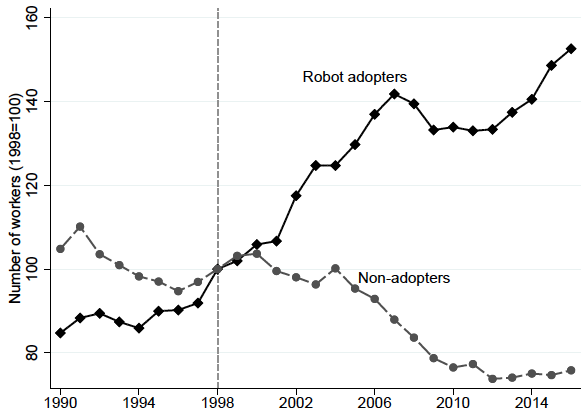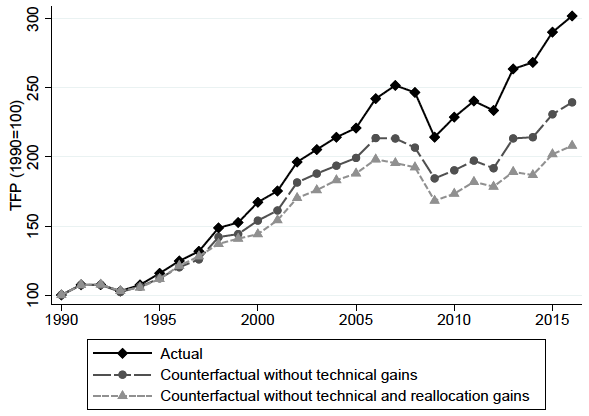Industrial robots are machines that perform delegated sets of tasks automatically – without any direct or constant interaction with a person. They thus replace human workers in specific production stages. According to the International Federation of Robotics (IFR), the number of industrial robots in operation is already very high (standing at two million in 2017) and expected to rise fast in the near future (at an annual rate of 16% over the following years). Considering the high speed of robot diffusion into a wide range of manufacturing activities, the issue of how automation affects modern labour markets has drawn a tremendous degree of attention among economists and policy advisers.
Frey and Osborne (2017) predict that almost 47% of total US employment could be automated in the nearest future. Focusing on the period from 1993 to 2007 and covering 17 different countries, Graetz and Michaels (2018) find that the growing intensity of robot use accounted for 15% of aggregate economy-wide productivity growth, contributed to significant growth in wages, and had virtually no aggregate employment effects. At the same time, Acemoglu and Restrepo (2017) investigate the US labour market between 1990 and 2007 and show that one additional robot per thousand workers reduces the employment to population ratio by about 0.2 percentage points and wages by 0.37 percent within commuting zones. Dauth et al. (2018) study Germany between 1994 and 2014 and find no effects on total employment, but identify a substantial shift in the composition of jobs away from manufacturing and towards business services.
Firm-level implications of robot technology
Existing studies provide the first important insights into how automation shapes aggregate outcomes such as employment or productivity at the country-industry level. However, they all make the crucial assumption that all firms in a given industry have the same ability and willingness to adopt robots. They do not take seriously the possibility that the same set of tasks is performed by human labour in some firms but is performed by robots in others. The literature thus provides little insight into the following central questions: Which firms adopt robots? What are the labour market effects of robot adoption at the firm level? And how do differences in robot adoption across firms affect the industry equilibrium? In recent research (Koch et al. 2019), we address these questions using a rich panel dataset of Spanish manufacturing firms over the 27-year period from 1990 to 2016. The use of detailed micro-level data allows us to open up new perspectives on the economic consequences and policy implications of robot technology (Raj and Seamans 2018).
Data
Our study is based on firm-level data from Spain, a country with one of the highest robot density levels per worker in Europe. The data come from the Encuesta Sobre Estrategias Empresariales (ESEE), an annual survey of around 1,900 Spanish manufacturing firms with rich and very detailed information about firms’ manufacturing processes, including the use of industrial robots and other advanced technologies, costs, prices, employment, and so forth. For the purpose of our research, the key aspect that sets the ESEE dataset apart from other datasets is that it contains direct information on the use of robots in the production process of individual firms. Hence, it provides a unique opportunity for studying the incentives for, as well as the consequences of, robot adoption at the firm level.
A first look at the data
Figure 1, constructed from the ESEE dataset, provides a clear indication that firm heterogeneity in the adoption of robots matters greatly for the labour market effects of robot technology. It demonstrates that firms that adopted robots between 1990 and 1998 (‘robot adopters’) increased the number of jobs by more than 50% between 1998 and 2016, while firms that did not adopt robots (‘non-adopters’) reduced the number of jobs by more than 20% over the same period. From macro-level information on robot use, as employed in the existing literature, it is impossible to identify and investigate this striking pattern in the data.
Figure 1 Evolution of firm-level employment for robot adopters versus non-adopters
Notes: The figure depicts the evolution of average firm-level employment (measured by the number of workers) in a balanced sample of firms from 1990-2016, separately for robot adopters (solid black line) and non-adopters (dashed grey line). Robot adopters are defined as firms that entered the sample in 1990 and had adopted robots by 1998. Non-adopters are firms that never use robots over the whole sample period.
Firm characteristics and robot adoption
We begin our empirical analysis by focusing on the adoption decisions of firms. We reveal strong evidence for positive selection, that is, we show that firms that adopt robots in their production process are already larger and more productive than non-adopters before adopting robots. Looking at firms’ internal skill composition of labour, we establish robust evidence that, conditional on productivity, more skill-intensive firms are less likely to adopt robots. Intuitively, a more complex production process requires a larger share of high-skilled workers; since these workers are more difficult to replace, there is a negative relationship between the skill intensity of the firm and the gains from automation. Finally, our data show that exporters are more likely to adopt robots than non-exporters, since the gains from doing so can be scaled up to a larger customer base.
Firm-level effects of robot adoption
We proceed by documenting a series of firm-level effects following robot adoption. To credibly control for non-random selection into robot adoption, we closely follow the econometric methodology proposed in the literature and combine a difference-in-differences approach with a suitable propensity score reweighting estimator. First, we find significant and positive output effects in the vicinity of 20-25% within four years. Second, we demonstrate that robot adopters increase rather than decrease total employment (by around 10%). This confirms the suggestive evidence from Figure 1. Finally, we show that the labour cost share decreases by 5-7%-points, while the average wage remains unchanged.
Robot adoption and intra-industry reallocations
In the final step of our empirical analysis, we investigate how non-adopting firms – i.e. firms that do not start using robots – are affected by the rise of robot technology, and how robots contribute to the evolution of aggregate productivity. We reveal significant job losses in non-adopting firms. Our estimates imply that 10% of jobs in non-adopting firms are destroyed when the share of sales attributable to robot-using firms in their industries increases from zero to one half. The same logic applies to changes in output and survival probabilities.
To shed light on the contribution of robots to gains in aggregate productivity, we distinguish between (1) direct efficiency gains within robot adopters, and (2) indirect gains through reallocation of labour from non-adopters to adopters. Figure 2 reveals that, without the availability and adoption of robot technology, total factor productivity (TFP) would have doubled over the period from 1990 to 2016 rather than tripled. Moreover, we see that direct technical efficiency gains explain about two thirds of the total TFP gains attributable to robots, while the gains due to labour reallocation explain the remaining third.
Figure 2 Actual versus counterfactual evolution of aggregate TFP
Notes: The figure depicts the evolution of aggregate TFP (constructed as the weighted average of firm-level TFP using employment shares as weights) in a balanced sample of firms from 1990-2016. The solid black line depicts the actual evolution; the long-dashed dark grey line depicts the counterfactual evolution eliminating firm-specific TFP gains due to robot adoption; the short-dashed light grey line depicts the counterfactual evolution eliminating firm-specific TFP gains due to robot adoption, as well as labour reallocations caused by firm-level robot adoption and rising robot density at the industry level.
Conclusions
We offer novel evidence on the implications of production automation through the use of robot technology. The novelty lies in our focus on the determinants and consequences of robot adoption at the level of individual firms. We provide strong support for a hitherto neglected mechanism, namely, that robot adopters expand their scale of operations and create jobs, while non-adopters experience negative output and employment effects in the face of tougher competition with high-technology firms. Aggregate productivity gains are partly driven by substantial intra-industry reallocation of market shares and resources following a more widespread diffusion of robot technology, and a polarization between high-productivity robot adopters and low-productivity non-adopters.
References
Acemoglu, D and P Restrepo (2017), “Robots and jobs: Evidence from US labour markets”, NBER Working Paper 23285.
Dauth, W, S Findeisen, J Suedekum and N Woessner (2018), “Adjusting to robots: Worker-level evidence”, Opportunity and Inclusive Growth Institute Working Paper 13, Federal Reserve Bank of Minneapolis.
Frey, C B and M A Osborne (2017), “The future of employment: How susceptible are jobs to computerisation?”, Technological Forecasting and Social Change 114: 254–280.
Graetz, G and G Michaels (2018), “Robots at work”, Review of Economics and Statistics 100(5): 753–768.
Koch, M, I Manuylov and M Smolka (2019), “Robots and firms”, CESifo Working Paper 7608.
Raj, M and R Seamans (2018), “AI, labor, productivity, and the need for firm-level data”, in The Economics of Artificial Intelligence: An Agenda, University of Chicago Press.








